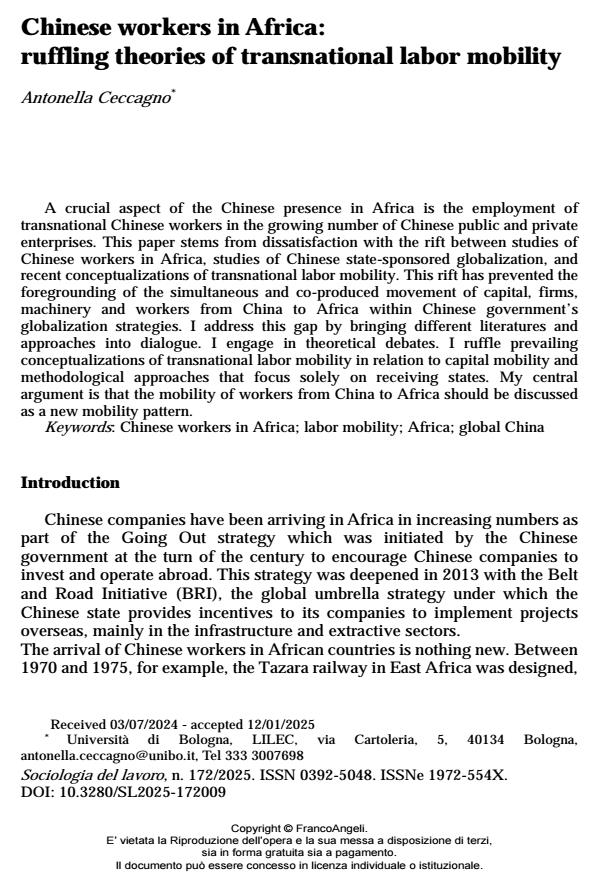Chinese workers in Africa: ruffling theories of transnational labor mobility
Titolo Rivista SOCIOLOGIA DEL LAVORO
Autori/Curatori Antonella Ceccagno
Anno di pubblicazione 2025 Fascicolo 2025/172
Lingua Inglese Numero pagine 16 P. 189-204 Dimensione file 113 KB
DOI 10.3280/SL2025-172009
Il DOI è il codice a barre della proprietà intellettuale: per saperne di più
clicca qui
Qui sotto puoi vedere in anteprima la prima pagina di questo articolo.
Se questo articolo ti interessa, lo puoi acquistare (e scaricare in formato pdf) seguendo le facili indicazioni per acquistare il download credit. Acquista Download Credits per scaricare questo Articolo in formato PDF

FrancoAngeli è membro della Publishers International Linking Association, Inc (PILA)associazione indipendente e non profit per facilitare (attraverso i servizi tecnologici implementati da CrossRef.org) l’accesso degli studiosi ai contenuti digitali nelle pubblicazioni professionali e scientifiche
A crucial aspect of the Chinese presence in Africa is the employment of transnational Chinese workers in the growing number of Chinese public and private enterprises. This paper stems from dissatisfaction with the rift between studies of Chinese workers in Africa, studies of Chinese state-sponsored globalization, and recent conceptualizations of transnational labor mobility. This rift has prevented the foregrounding of the simultaneous and co-produced movement of capital, firms, machinery and workers from China to Africa within Chinese government’s globalization strategies. I address this gap by bringing different literatures and approaches into dialogue. I engage in theoretical debates. I ruffle prevailing conceptualizations of transnational labor mobility in relation to capital mobility and methodological approaches that focus solely on receiving states. My central argument is that the mobility of workers from China to Africa should be discussed as a new mobility pattern.
Un aspetto cruciale della presenza cinese in Africa è l'impiego di lavoratori cinesi transnazionali nel crescente numero di imprese pubbliche e private cinesi. L’articolo nasce dall'insoddisfazione per la frattura che separa gli studi sui lavoratori cinesi in Africa, quelli sulla globalizzazione sponsorizzata dallo stato cinese e le concettualizzazioni sulla mobilità transnazionale del lavoro. Questo ha oscurato il movimento simultaneo e co-prodotto di capitali, imprese, macchinari e lavoratori dalla Cina verso l’Africa, nell'ambito delle strategie di globalizzazione del governo cinese. Nell’articolo provo a ricomporre questa frattura facendo dialogare approcci differenti. Mostro poi i limiti delle concettualizzazioni sulla mobilità transnazionale del lavoro e degli approcci metodologici che nello spiegare la mobilità dei lavoratori si concentrano solo sui paesi di arrivo. Suggerisco che la mobilità dei lavoratori cinesi in Africa andrebbe discussa come un nuovo modello di mobilità.
Parole chiave:Lavoratori cinesi in Africa; mobilità del lavoro; Africa; Cina
Antonella Ceccagno, Chinese workers in Africa: ruffling theories of transnational labor mobility in "SOCIOLOGIA DEL LAVORO " 172/2025, pp 189-204, DOI: 10.3280/SL2025-172009